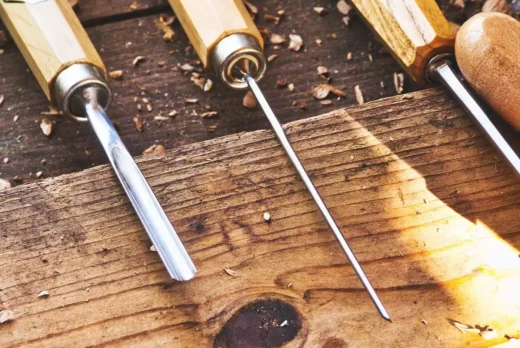Essential tools every home woodworker should have in their workshop, Building cutting wood tips, Woodworker advice
Essential Tools Every Home Woodworker Should Have in Their Workshop
8 April 2025
For anyone interested in building furniture, repairing items around the house, or creating something entirely from scratch, woodworking begins with the right tools. We will explore the essential items that make a home workshop functional, productive, and rewarding. A solid set of tools helps ensure each project starts with accuracy and ends with stability and pride.
Whether working in a garage, basement or dedicated shed, building a reliable collection of woodworking tools is not about quantity—it’s about choosing versatile, durable options that help turn ideas into finished pieces. The first steps toward a satisfying woodworking hobby often begin with assembling this toolkit. From measuring and cutting to shaping and joining, the right tools serve as the foundation and the roadmap for progress. A well-equipped workshop empowers creativity while reducing frustration, making the craft more accessible for anyone looking to take on projects confidently. Once the tools are in place, the possibilities open up.
Essential items that make a home workshop
- Measuring and Layout Tools: The Starting Point of Accuracy
Precision starts with planning, meaning every woodworking project must begin with dependable measuring and layout tools. Even the slightest miscalculation can lead to gaps, uneven joints, or an unstable structure. A quality tape measure is a fundamental starting point—it’s used for everything from marking lumber to checking final dimensions. A combination square provides both 90-degree and 45-degree angles, essential for marking cuts and aligning pieces.
A marking gauge or wheel allows clean, accurate scribe lines that follow the grain rather than fighting it. A reliable straightedge and a good set of pencils help translate designs onto the wood in visible but not disruptive ways. A carpenter’s square or framing square can help square up panels or verify larger assemblies for a more advanced layout. Accuracy during the measuring phase separates a seamless joint from a frustrating misalignment. This attention to detail also reduces waste by avoiding re-cuts and misfits. Whether building a picture frame or a kitchen table, starting with clean, straight, and accurate marks ensures that each subsequent step builds on a solid foundation. Measuring tools often look simple, but their correct use is the difference between a job well done and a project full of compromises.
- Cutting Tools for Clean, Controlled Shapes
Once the layout is complete, it’s time to cut; this is where a workshop starts coming alive. Saws come in many forms and serve different purposes, but each type of cut requires the right tool. A handsaw is an indispensable choice for straightforward cuts, especially when power tools aren’t available. A jigsaw adds versatility, allowing for curved and intricate cuts that would be difficult to do by hand. Circular saws are ideal for long, straight cuts in larger panels or sheet goods, while a miter saw helps with precision angles, making it easier to build frames or trim pieces. A dovetail or pull saw provides more control and cleaner results for joinery or finer work.
Safety and precision go hand in hand when cutting, so understanding the wood’s grain, securing the piece, and maintaining a sharp blade are all important. Dull knives lead to tear-out, splintering, or slipping, affecting the outcome and the operation’s safety. Adding clamps, push sticks, and dust collection can improve the experience for those working with power saws. Cutting tools opens the door to shaping wood, and mastering them allows the woodworker to take on increasingly complex projects with skill and confidence.
- Tools for Shaping, Smoothing, and Refining Surfaces
After the wood is cut to size, it rarely fits together perfectly without some shaping and smoothing. This stage adds finesse to the rough cuts and prepares the surface for joinery or finishing. Hand planes are invaluable here, offering the ability to shave down high spots, flatten panels, or create smooth edges. A block plane, in particular, is versatile for trimming end grain and fine-tuning fit. Sandpaper and sanding blocks, while often underestimated, are vital for getting surfaces smooth enough for finishing. A random orbit sander saves time and effort for larger projects, especially when dealing with panels or broad surfaces.
Chisels also play a key role in this phase. They allow for removing small amounts of wood, cleaning mortises, or creating fine joinery details. A good set of sharp chisels combined with a mallet can shape or carve intricate forms with accuracy and control. Files and rasps help refine curves and edges, making them perfect for custom-shaped furniture or decorative work. Smoothing is about preparation—how the wood feels, how it bonds with glue or finish, and how well it fits with the other components. Neglecting this step can mean joints don’t close properly or finishes highlight flaws rather than beauty. The shaping stage bridges the rough structural cuts and the final, polished outcome, and the tools used here reflect the woodworker’s touch more than any other.
- Joining Tools That Bring Pieces Together Securely
Joinery is the heart of woodworking—it turns individual pieces of wood into furniture, cabinets, or decor. Whether using traditional or modern techniques, every home woodworker should have reliable tools for making and securing joints. Clamps are essential in this process. From bar clamps to C-clamps to pipe clamps, having a range of sizes ensures that pressure is applied evenly while glue sets. A basic drill and a set of bits add versatility, allowing for pocket holes, dowels, or pilot holes for screws. Doweling jigs, biscuit joiners, and pocket hole jigs all simplify the alignment process and increase the bond’s strength. Instead of a metal hammer, a mallet provides a gentler touch when assembling tight joints, reducing the risk of damaging the workpiece.
Wood glue plays a critical role, too, acting as the unseen but strong connection that gives the structure its resilience. Understanding how different joints work—lap joints, mortise, tenon, dovetail—allows the woodworker to choose the best method for the project’s demands. These tools don’t just help hold things together; they influence the finished product’s quality, appearance, and longevity. Good joinery speaks to the care and thought that went into every cut and decision. To go deeper into technique, design tips, and workshop planning, many learn woodworking with the Woodwork Handbook as a helpful guide. Equipped with knowledge and the right tools, any home woodworker can turn ideas into well-crafted reality.
A well-rounded workshop doesn’t need to be extensive to be effective. With the right tools, even a tiny space can become a place of creativity, craftsmanship, and satisfaction. The essential gear for measuring, cutting, shaping, and joining allows anyone to take on various projects with a sense of control and purpose. Each tool serves a function, and when combined, it makes it possible to build beautiful and functional pieces. Whether it’s a gift, a household repair, or a personal challenge, woodworking offers a way to connect with materials and processes in a rewarding way. Understanding how these tools work together is a big step forward for those just getting started or looking to improve their setup.
Comments on this Essential Tools Every Home Woodworker Should Have in Their Workshop article are welcome.
Woodworking
Woodworking Posts
Home remodelling Need a reciprocating saw
How to plunge cut with a fixed base router
Ultimate Guide to CNC Process for Architectural Work
Home Articles
Residential Architecture
Comments / photos for the Essential Tools Every Home Woodworker Should Have in Their Workshop page welcome







